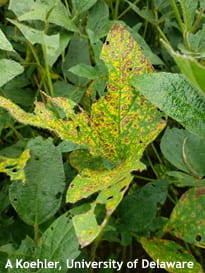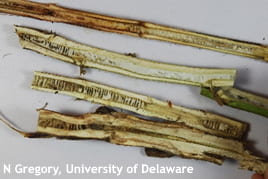Alyssa Koehler, Extension Field Crops Pathologist; akoehler@udel.edu
We are reaching the time of year when we begin to see leaf symptoms developing in soybean. Soybean diseases can look very similar to one another and to add complication, there can be multiple diseases occurring in the field at the same time or abiotic factors that look similar.
Fields with nematode pressure are often more susceptible to fungal diseases such as soybean sudden death (SDS) or brown stem rot (BSR). For SDS, infection by the causal fungus Fusarium virguliforme usually occurs within the first 2 to 3 weeks after germination, but we don’t typically see symptoms until the plant is in reproductive phases and the level of symptom development varies greatly from year to year. Infection is favored by early planting into cool and wet soils and often is in combination with infection by soybean cyst nematodes (SCN) or RKN. Symptoms of SDS are typically worse in years with heavy early rainfall (or in irrigated fields).
So far this season I have not seen many fields with SDS. Symptoms begin in the roots where the vascular tissue of the taproot becomes brown. These symptoms are usually below the soil line and the symptoms that really stick out are the patchy yellow lesions in the leaves that expand between the veins to brown lesions surrounded by chlorotic areas. While this can look very distinctive, it is important to remember that this leaf symptom can actually appear following multiple causes. Other diseases with similar symptoms include various stages of infection by the fungus Diaporthe (stem canker, pod and stem blight, seed decay), BSR, charcoal rot, and others. While there are often exceptions to the rules or cases where multiple diseases can be present at the same time, the table below can be a starting point for separating some of our common fungal soybean diseases (Table 1).
This year I have also received calls from intensively managed fields that have leaf symptoms from application of fungicide in hot weather (Figure 1). Triazole (DMI) fungicides can have phytotoxicity injury that varies based on adjuvant, fungicide rate, soybean genetics, and environmental conditions at the time of planting. Injury will be on the leaves in the upper canopy that are expanding when the application is made. The key is that leaves do not tell the whole story, so it is important to look closely at the base of the stem, at roots, and to split stems to see what is happening within. One of the diagnostic signs for SDS are the blueish structures (sporodochia) at the base of the plant near the soil line. These can turn white once exposed to air, so it is best to look for them right as you are digging plants or if you have had plants incubating. Splitting stems is another way to sort out SDS, BSR, and charcoal rot. When splitting stems, SDS usually has brown outer vascular tissue (cortex), while BSR is brown in the center (pith) and the vascular tissue is usually still healthy looking. Charcoal rot will have numerous black dots called microsclerotia that are present on the outer stem and within the stem (Figure 2). Diseases from Diaporthe spp. will tend to have healthy looking vascular and pith tissue, but you may see black zone lines.
Table 1. Sorting out soybean diseases with similar foliar symptoms
| Diaporthe species | Sudden Death Syndrome | Brown Stem Rot | |
| Leaves | Leaves typically stay attached. | Leaves fall off, can look like deer browsing. | Leaves typically stay attached. |
| Symptom |
Foliar symptoms from stem canker/pod and stem blight caused by Diaporthe species |
 Foliar symptoms from SDS caused by Fusarium virguliforme Foliar symptoms from SDS caused by Fusarium virguliforme |
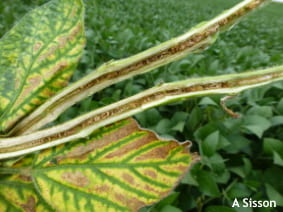 Foliar and stem symptoms of brown stem rot. Foliar and stem symptoms of brown stem rot. Photo: https://cropprotectionnetwork.org/resources/articles/diseases/brown-stem-rot-of-soybean |
| Sign |
 Small black dots (pycnidia) may be in rows on stem tissue Small black dots (pycnidia) may be in rows on stem tissue |
 Blue sporodochia at the base of a soybean plant with SDS. Blue will often fade to white after exposure to air, so check soon after pulling up the plant. Blue sporodochia at the base of a soybean plant with SDS. Blue will often fade to white after exposure to air, so check soon after pulling up the plant. |
none |
| Taproot |
Split stem has limited discoloration and may have zone lines. |
Browning on either side of the interior. Roots will be discolored. |
Browning in the pith. BSR does not affect roots. |
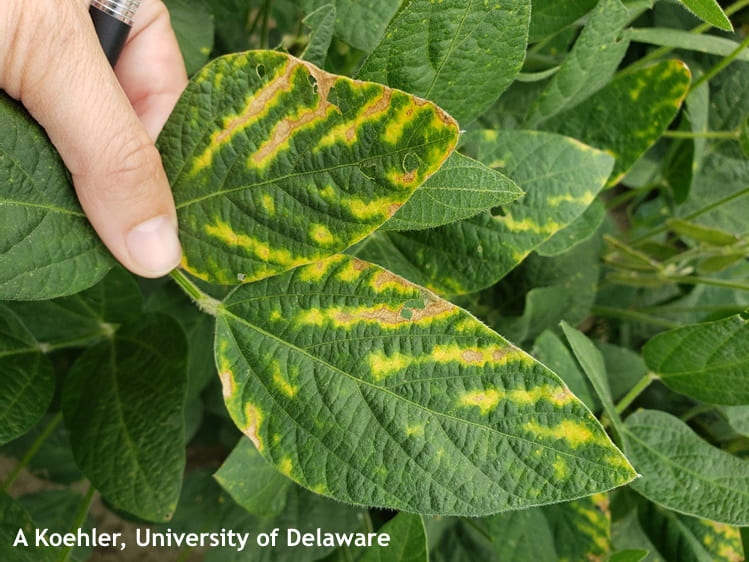
Figure 1. Soybean leaves with triazole phytotoxicity

Figure 2. Microsclerotia of the fungus Macrophomina phaseolina causing charcoal rot in soybean. On the outside (A) and within a soybean stem (B)
As we approach late August and September, damage from root-knot nematodes can also become more visible. Often we will see plants with stunting, leaf symptoms, or patches of dead plants. These areas with RKN will usually drop leaves early and really stick out compared to healthy green plants nearby (Figure 3). When these plants are pulled from the ground, root systems will often have very notable galling (Figure 4).

Figure 3. Field with patches of yellow and dying soybeans due to root knot nematode.
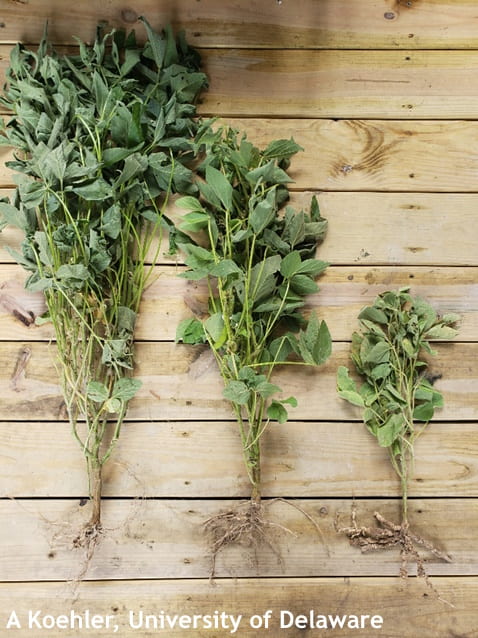
Figure 4. Soybeans from the same field with height differential due to various levels of root galling from root-knot nematode.

